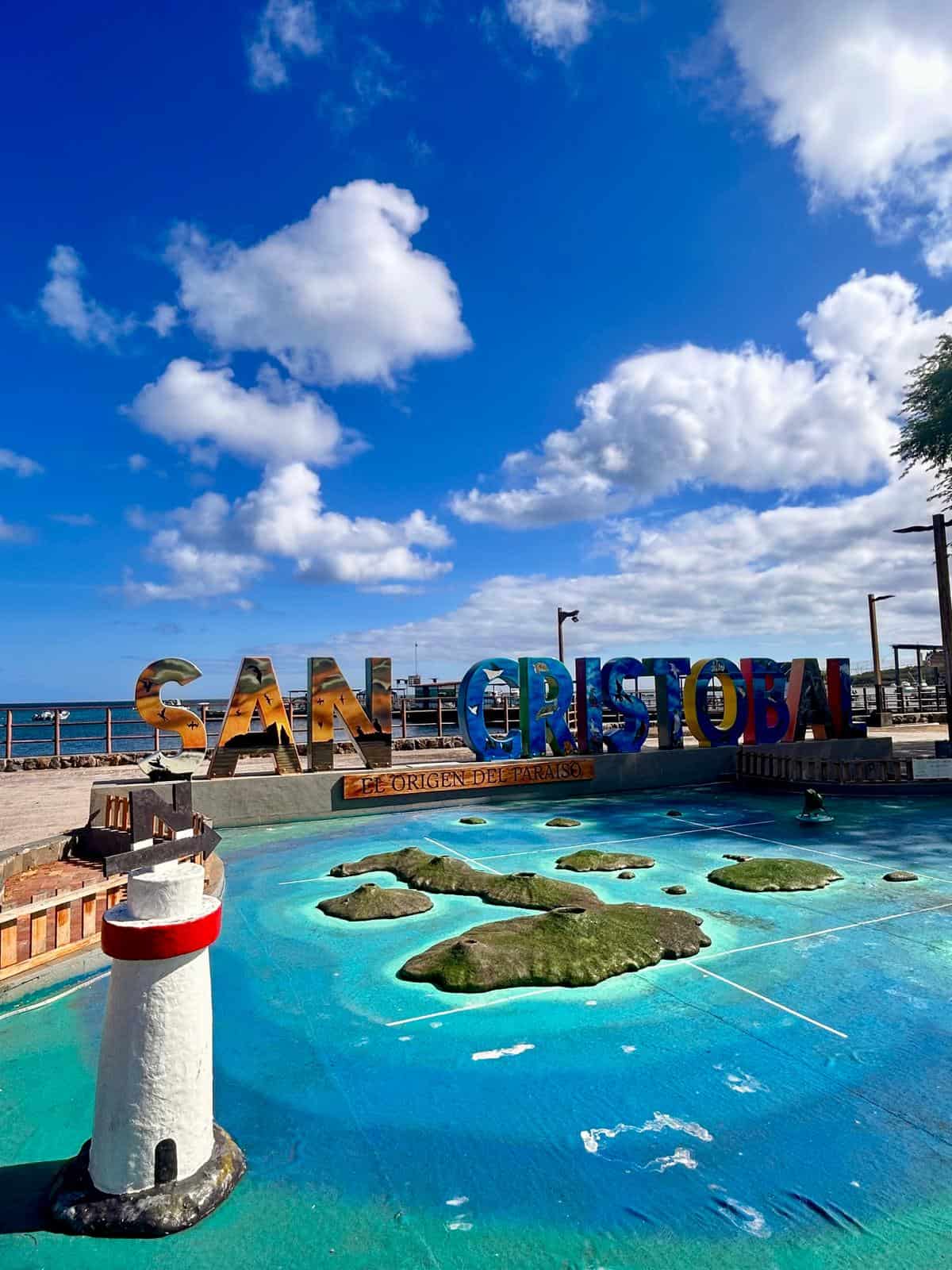
What to do on San Cristóbal Island in the Galápagos? When people talk about the Galápagos, they usually imagine two things: a wild animal wonderland and a bank-draining, once-in-a-lifetime trip. We’re here to tell you that the second part doesn’t have to be true. As always, we like to debunk travel myths and give you the juicy details, so you can plan your adventure to these mystical places without selling your soul or your surfboard.
Now I’ll be honest. Not that long ago, I thought the Galápagos were co-owned by a few South American countries. Wrong! Classic American girl getting a geography lesson on the road. Fast forward to a surf trip with a friend on the mainland of Ecuador, and we found ourselves in the thick of la garúa (that misty coastal fog), craving the sun. Everyone told us that if you want sunshine this time of year, the Galápagos is the place to be. One quick search later, and we discovered that not only is San Cristóbal one of the main inhabited islands—it also has surf. Our mission was clear.
Wondering what to do on San Cristóbal? We’ve got you covered!


Lay of the Land
In an archipelago of 19 islands (13 major and 6 smaller ones), only four are inhabited. With that said, you can visit most of them with proper planning. What makes the Galápagos so mind-blowing isn’t just the scenery—it’s the animals. These volcanic islands rose from the ocean millions of years ago, with no native mammals in sight. The species that managed to arrive adapted in wild, creative ways. Think black swimming iguanas, birds with bright blue feet, and giant tortoises that can live over a century. With no natural predators, many of the animals here evolved to be fearless (dare we say tame?)—and they still are. Birds waddle right up to you. Sea lions snooze beside your towel. It was this very uniqueness that inspired Charles Darwin’s theory of evolution when he visited in 1835.


Here’s a quick peek at the four habitable islands:
• Santa Cruz – The most developed and bustling, with Puerto Ayora as its main town. Good base if you want easy tours, fancier lodging, or are traveling with family.
• Isabela – Rugged and remote-feeling. Think long beaches, dirt roads, and wild beauty.
• Floreana – Quiet, off-the-grid, and mostly untouched. If you’re craving solitude, this is your island.
• San Cristóbal – Our pick. Home to surf, sunshine, and its own airport. You can land and paddle out within the hour. At last, what to do on San Cristóbal? We’ve got you covered.


Budget Breakdown
You can do the Galápagos on a range of budgets. The tours will likely be your most significant expense, but there are plenty of ways to stay in budget:
• Grocery stores and bodegas are perfect for stocking up on water, snacks, and simple staples.
• Eating out? Grab a local meal of protein, rice, beans, and salad for around $6, available all over town.
• Bring your own snorkel gear or goggles for a peek underwater anytime you want.
• Craving pizza or sushi? That’s there too, but expect tourist prices. You can truly tailor the experience to your cravings and budget.
Pro Tip ~ Don’t miss trying encebollado—a hearty Ecuadorian stew with fish and yuca, in a light tomato broth topped with tangy onions and fresh lime juice. It’s the go-to for breakfast, post-surf recovery, or hangover salvation. You can’t eat it just once.


Getting There
To fly to the Galápagos, you’ll depart from either Quito or Guayaquil. Even if you start in Quito, most flights route through Guayaquil before heading to the islands. The flight time from Guayaquil to San Cristóbal is an easy 1 hour and 45 minutes.
Interesting Fact ~ You can only fly to the Galápagos from mainland Ecuador.
Airport & Park Fees
• Purchase a Transit Control Card ($20) at the designated booth near the gate check-in area at your mainland Ecuador airport (they accept credit cards).
• Show proof of your exit flight from the Galápagos—no exceptions.
• Go through an additional luggage inspection to protect the islands’ ecosystem.
Upon landing in San Cristóbal, you’ll pay the national park entrance fee ($200 when I visited), which gives you access to all protected areas across the islands—no additional costs to hop between them. When you divide this number by how many days you’re staying, it beats any zoo, amusement park, or festival pass.
Taxis are waiting right outside the airport, and most are beefy trucks. Toss your bags in the back and you’re off.
Packing Tip ~ Research the weather during your stay. In June, we wore shorts and tanks during the day and grabbed a shawl at night. Bring plenty of sunscreen, you will be right on the equator!


Where to Stay
Puerto Baquerizo Moreno is the main town on San Cristóbal and your home base. It is well-kept, safe, and easy to navigate. The rest of the island is wild and protected—so you’ll stay here, and adventure outward.
The town is lively. Expect to see sea lions snoozing on benches, kids playing in the plaza, bright street art, and a laid-back mix of local life and travelers. There’s accommodation for most budgets. We stayed just up the hill from town and loved getting those extra steps in daily! We paid around $30 per day for private rooms at our cozy guesthouse.


What to do on San Cristóbal?
Activities! And the options are endless.
Excursions
Excursion offices line the main streets, so don’t stress if you arrive without anything booked. One of the most popular options is the 360 Tour, which loops you around the entire island by boat.
• We snorkeled (or free-dived, let’s be honest), chilled on pristine beaches, spotted rare wildlife, and had a tasty lunch—all included. It was an exceptional experience to witness the entire island from the water.
• The highlight was Kicker Rock, where we dove with tiger sharks, turtles, eagle rays, and countless fish. Truly next level.
360 Tour prices range from $140 to $180+, depending on season, boat size, and inclusions. The tour takes about 8 hours. Shop around, read reviews, and trust your gut.

We also pieced together our version of the Highlands Tour as we wanted to visit these sites at our leisure:
• El Junco Lagoon (the only freshwater lake in the islands).
• La Galápaguera (a giant tortoise breeding center).
• Puerto Chino Beach (turquoise water, soft sand, and surf if the swell is right).
For the mountain bikers, this island is your playground. For the travelers who rent a mountain bike on a whim because they are ‘athletic’. Guilty and good luck.


Walks & Hikes
You’ll walk a lot on San Cristóbal—and that’s part of the magic. Bring sneakers and keep your snorkel gear in tow.
• La Lobería – A rugged stretch of beach where sea lions rule the sand and marine iguanas bask on lava rocks. A solid walk or run to get there, but worth it.
• Punta Carola – Our go-to sunset spot. This beach is full of sea lion drama and is one of the best places to observe nature in action.
• Playa Baquerizo – A bit of a mission (40 minutes past Punta Carola), but the most secluded beaches we reached on foot. Great snorkeling with turtles and sea lions. Wear shoes, the trail gets rocky.
Pro tip ~ Hit up The Pier Restaurant & Cevichería on your way back from Punta Carola. Best sundowners on the island.


Scuba Diving & Snorkeling
Scuba diving and snorkeling are abundant on San Cristóbal. If you’re into big marine life, plan your dive around, you guessed it ~ Kicker Rock. It’s famous for hammerheads. If sharks aren’t your vibe, there are plenty of other dive sites to choose from, each with their own wild lineup.
Snorkeling is everywhere—and honestly, you might be ruined for life. No underwater plunge may ever compare. Consider yourself warned.
Our favorite? Cerro Tijeretas. The sea lions swam inches from our faces, blew playful bubbles, and zipped circles around us like aquatic puppies. It was so magical, we went back the next day.

Surf
San Cristóbal quietly boasts some world-class waves, which made the visit even more special. Here’s where to surf and what to know:
• Tongo Reef – The crown jewel. A fast, left-hand point break for experienced surfers. Only accessible by boat. Organize through the local surf shop or a boat driver.
• La Lobería – A powerful reef break that works on bigger swells. Not for beginners.
• Playa Mann – A gentle beach break in town. Great for beginners or a chill paddle.
• Punta Carola – Lefts that wrap into the bay when the swell’s right. Sea lions often share the lineup.
• Puerto Chino – Off-the-beaten-path and dreamy, you’ll need to arrange a taxi to get there and back. There needs to be a swell, but we scored a fun session here—and had the place to ourselves.
Surfboard rentals start around $30/day. If you’re coming to surf, bring your own board to save cash and ride what you know.


The Most Magical
San Cristóbal is one of the most magical places I’ve ever been. Every day feels like walking through a wildlife documentary. Of course, there are no cages, no boundaries, just you and nature at its rawest. You will want to touch, pet, and cuddle with a sea lion SO bad. It will be extremely hard to resist. This is a harsh reality, my friends.
To recap, what to do on San Cristóbal? Watch sea lions nap like retirees. Snorkel in gin-clear water next to ancient turtles. Witness aquatic iguanas. Swim with sharks. Surf in the middle of the Pacific off a lava coastline. Hike through volcanic terrain to a beach with no one else in sight. Eat encebollado for breakfast. Repeat.
We stayed for 8 days and loved the slow rhythm. Rather than island-hopping, we rooted in San Cristóbal—and it gave us everything. We moved with wonder, taking in each magnificent moment. If you’re dreaming of the Galápagos but worried about the cost, the logistics, or the hype—don’t be. This place is real. It’s reachable. It’s absolutely radical. And if you’re lucky, it’ll rock your soul and keep you daydreaming until you return.
Stay wild,
Bekah
PS ~ For another South American adventure, check out our article all about hiking The Lost City in Colombia!
